Here at Gun Tests we do not often address intangibles. We measure performance in a logical manner. We test firearms, devices, and ammunition in a repeatable and verifiable manner. We do so in order to produce a level playing field for products. This is a credible standard for comparison. Just the same, sometimes a concept is worth a hard look. This month we are addressing the concept and execution of holsters that are designed to fill more than one mission. We have explored the concept and found that, at least in the case of some of the holsters tested, the concept is viable.

We wondered, is it possible to have a holster that fulfills several different jobs. Or would we find the truth of the adage, “jack of all trades—and master of none,” and learn that a certain holster style is suited only to a single style of deployment? There have been numerous multi-function holsters advertised to fill more than one mission. We chose to cover six holsters that have been advertised as multiple-role holsters. These range from more-or-less standard holsters with extra belt loops to a holster with multi-directional belt loops.
But inquisitive GT readers (you know who you are) will challenge: Why compromise at all? Why not simply choose a single holster for each mission? Realistically, who wants to have to swap rigs to move from car to office to restaurant, especially for those of us living in a true four-season climate? If one holster can work inside the waistband (IWB) for concealment, as a strong-side belt scabbard offering real speed and comfort, and as a cross-draw holster for those who are seated or driving most of the day, that would indeed be a valuable piece of kit. Also, with quality custom leather and Kydex holsters approaching $100 dollars or more, it is important that we make a good choice.
Our test products were the Ted Blocker X 16, $97; Tauris Double Shift, $160; K&D Holsters’ Thunderbird Defender, $95; Raven Concealment Systems Phantom, $90 (which includes an optional $20 loop kit); Simply Rugged Tribute, $95; (which includes $10 for IWB loops); and the Classic Old West Styles Four Way Holster, $38.
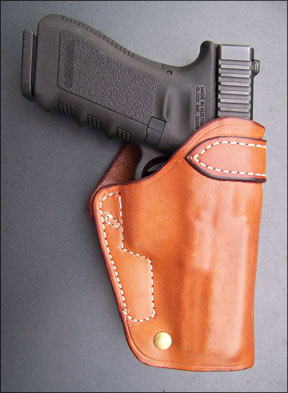
To start, we examined these units with an eye toward assessing the use of good materials, professional surface finish, and tight, durable stitching. How well the holsters function in the field is another matter, so we tested these holsters on the body extensively. Several team members wore a rig for at least a week each, then traded off holsters to various raters. We also drew handguns from them and shot targets at a range.
In particular, we focused on cant and rake during our field and shooting assessments. Cant is the angle of the holster away from the body. Rake is the angle of the muzzle. If the muzzle is pointed to the rear or spine of the holster, it’s is a “rear rake” design. Almost all holsters are a rear rake design. A very few are a neutral cant, useful for the most part with compact handguns. The forward rake holster is most often seen as a competition holster for very tall shooters. A forward rake would expose the butt to printing on the garments and would be unsuitable in a concealed-carry holster.
At the end of the field and range work, we compiled the tester’s pro-and-con comments during a roundtable discussion. To avoid a lackluster “jack of all trades, master of none” nomination, the holsters had to receive an A grade in one of their design missions and at least a B grade in the second. In other words, a strong-side holster that could be carried as an IWB needed an A grade as a strong side and a B grade as an IWB to pass.
Ted Blocker X 16, $97
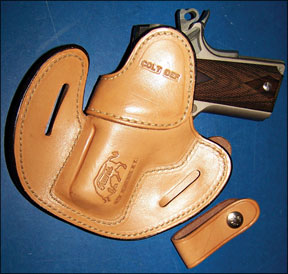
The Blocker X 16 is a holster that features a nearly neutral draw angle. As such, it may be used as a strong-side holster or as a crossdraw. One of our raters worked with several agencies during a 20-year law-enforcement career and used the Blocker X 16 holster for the SIG P220, Colt 1911, and Glock Model 37, all with good service. He reports he carried the SIG primarily on the strong side and the Glock primarily on the cross draw. The 1911 he carried in both stations with excellent results. Our raters found the X 16 to be well made, with the tanning cited as particularly good. Our test example was crafted for the Government Model 1911. We first set the piece up as a strong side. We took turns drawing from under a concealment vest. The elbow is shot to the rear and the pistol scooped out of the holster. Our team said the holster was fast enough. The X 16 holster featured a retention screw. When moved to the cross-draw position, the handgun is comfortable on the belt. The nearly neutral cant makes for good comfort when worn cross draw. One of our raters has taught the cross-draw in an agency environment. A disadvantage of the cross-draw is that the muzzle sweeps across the target rather than into the target, as is the case with the strong-side deployment. In other words, if you draw from strong side and fire the shot at the wrong time, you will strike from the toe to the brow of the adversary. The cross-draw shooter
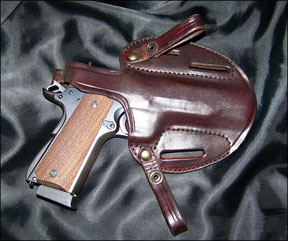
who fires at the wrong time will strike a narrow band, if he strikes the target at all. Our rater teaches to angle the body toward the attacker with the weak side facing the attack. The hand shoots to the pistol and draws into the attack. This draw eliminates many of the shortcomings of the cross-draw motion. The Blocker X 16 is ideal for this type of draw, we thought.
Our Team Said: The Blocker holster gets an A in both strong-side and cross-draw versions. For more information, contact www.TedBlockerHolsters.com.
Tauris Double Shift, $160
This holster is designed from inception as a dual-purpose holster. A pancake style, the Tauris double shift is designed by an experienced leather crafter. As a strong-side unit, the holster rides close to the body with good concealment, but it allows a sharp draw with an adequate draw angel. The reinforced holster welt, or holster mouth, assures that the operator can holster the pistol and prevent the holster mouth from collapsing after the pistol is drawn. There is a good balance of speed and retention, our team said. Carried tucked between the pants and the body as an IWB, the Double Shift offered concealment and was comfortable as these holsters go. Draw angle was not compromised. IWB holsters are often prone to shifting, but this wasn’t a problem with the Double Shift.
Our Team Said: This holster performed well in both the IWB and strong side mode of operation. For more information,
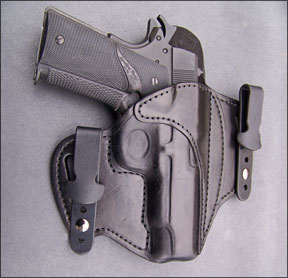
contact www.TaurisHolsters.com.
Simply Rugged Tribute, $95
The Tribute was designed as a tribute to Roy Baker, the man largely responsible for creating and popularizing the pancake holster. The Tribute is a well-made holster that offers good concealment, even for larger handguns such as the 1911. The Tribute is offered with two options, a thumb-break retaining strap and an additional set of three removable belt loops that provide the option of wearing the Tribute IWB—an important advantage. This allowed a considerable range of adjustment as a strong-side belt holster.
With the greatest tilt, using the upper belt loop, we found that the Tribute worked well with a 3 o’clock cant. Speed was good, and the thumb break was crisp in operation and sturdy. We also tested the holster with the belt through the lowest loop and found it acceptable. A tall shooter would probably prefer this loop.
Our Team Said: An advantage of the Tribute as an IWB holster is the intelligent position of the IWB belt loops. They are angled so as to provide a 3 o’clock cant. Loop placement itself is what matters. For more information, contact www.SimplyRugged.com.
K&D Holsters Thunderbird Defender, $95
The Thunderbird Defender features a nearly vertical scabbard for strong-side use. We tried this holster as a strong-side holster first. Results were good, but the holster is quite tight in its fit to the body. This is good for concealment, but you must master the draw. The sweat guard, usually a feature of an IWB holster, was welcome in the strong-side holster as well. In our tests, the holster was not quite as fast as the Tribute as a strong-side holster, but it was flatter. As an IWB holster, our shooters found the Thunderbird was quite flat and offers real speed and concealment. The loops should be removed for strong-side carry because they may snag on garments during the draw, or that they

do not flap loosely when carried.
Our Team Said: This holster rates an A as an IWB, but we thought it rode a bit close for a fast draw on the strong side, which is supposed to be faster than the IWB. For more information, contact KDHolsters.com.
Raven Concealment Systems
Phantom, $90
For most of us, Kydex is an acquired taste. This holster was a well-designed concealment style whose Kydex was thick enough to maintain its shape and retain the handgun well, but was thin enough for comfort and concealment. The Phantom was offered as a dual-purpose strong-side and inside-the-waistband holster. The body was riveted together, but do not get the impression that the rivets are drilled for screws, they are not, only enough for use with the supplied belt loops. The synthetic belt tunnels for strong-side use are hard-synthetic units and the IWB loops are soft, thick rubber. When properly worn behind the hip as a strong-side holster, the Phantom is brilliantly fast. We shot our elbow to the rear and scooped the P7 out smartly. If there is a faster holster we have not tried it. Because a Kydex holster retains the firearm by holding pressure on the trigger guard and the long bearing surfaces, there is a tell tale snik as the piece is drawn.
Our Team Said: For IWB wear, we had mixed feelings not related to the design, but rather the material. Kydex is not as supple as leather, and that is its advantage. It will never lose its shape. After some experimentation, positioning the Phantom dead over the back pocket in the small of the back proved bearable for all raters. For more information, contact www.RavenConcealment.com.
Classic Old West Styles Four Way Holster, $38
The COWS four-way holster may be worn strong side, with a pronounced FBI cant, as a small-of-the-back holster, or as a cross-draw. To grade it on a two-way scale as we did the others, our testers concentrated upon what they deemed were its strongest uses, strong-side and SOB use. We experimented with the cross-
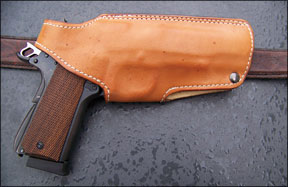
draw setup and found the angle too severe for concealed carry, in our opinion. The angle was odd and none of the raters, tall or short, could find a good cross-draw angle. Much the same may be said for the FBI tilt option. The tilt was too severe for concealment or a sharp draw. So, two of the four advertised carry options were found unsuitable.
As a scabbard design and as a pancake the holster, our team found it does not ride close to the body, but all who tested the holster found it to be a good strong-side holster. The thumb break was easily deployed on the draw. We especially liked the generous draw angle. This was a fast holster with a bit of practice. As a SOB holster, the Four Way rides at an angle that allows good concealment. There is no danger of the handgun falling from the holster because the thumb-break prevents it. Most SOB holsters require a severe tilt to keep the handgun from falling from the holster, even when they are tightly boned. The Four Way solves this problem.
Our Team Said: In the end, the Classic Old West Styles Four Way Holster gets an A for strong-side carry and SOB style, but an F in any other mode. Considering the modest price, two out of four isn’t bad, but a purchaser wishing to use the four way as a cross-draw will be disappointed, our testers said. Log on to www.cows.com to learn more about the Four Way Holster.


























